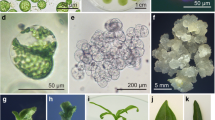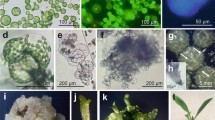Abstract
Petiole protoplasts from in vitro-grown carrot plants are a very good alternative to traditionally obtained protoplasts from suspension cultures. High plating and regeneration efficiencies were obtained in most of the breeding lines that were tested. The embedding of the protoplasts in alginate was crucial for initiating cell division and further development. Several streptomycin resistant and chlorophyll-deficient plant lines were selected for using the petiole protoplast system. Maternally inherited streptomycin resistance was demonstrated by sexual crosses. Protoplast fusion of several chlorophyll-deficient lines did not result in complementation, indicating the cytoplasmic nature of the mutations. Petiole protoplasts were used for direct transformation with plasmid DNA pNUNV containing NPTII as a selectable marker. High transformation frequencies (up to 1%) were obtained after PEG treatment of the protoplasts. Kanamycin resistance was shown to be inherited as a single dominant nuclear trait.
Similar content being viewed by others
References
Damm B, Schmidt R, Willmitzer L (1989) Efficient transformation of Arabidopsis thaliana using direct gene transfer to protoplasts. Mol Gen Genet 217:6–12
Dewulf J, Negrutiu I (1991) Direct gene transfer into protoplasts: the chemical approach. In: Negrutiu I, Gharti-Chhetri G (eds) A laboratory guide for cellular and molecular plant biology. Birkhäuser, Basel Boston Berlin, pp 116–121
Droge W, Broer I, Puhler A (1992) Transgenic plants containing the phosphinotricin-N-acetyltransferase gene metabolize the herbicide l-phosphinotricine (glufosinate) differently from untransformed plants. Planta 187:142–151
Dudits D (1984) Isolation and culture of protoplasts from carrot cell suspension cultures. In: Vasil (ed) Cell culture and somatic cell genetics of plants. Academic Press, Orlando London, pp 391–397
Dudits D, Kao KN, Constabel F, Gamborg OL (1976) Fusion of carrot and barley protoplasts and division of heterocaryocytes. Can J Genet Cytol 18:263–269
Dudits D, Hadlaczky G, Lévi E, Fejér Haydu, Zs, Lázár (1977) Somatic hybridisation of Daucus carota and D. capillifolius by protoplast fusion. Theor Appl Genet 51:127–132
Gamborg OL, Miller RA, Ojima K (1968) Nutrient requirements of suspension cultures of soybean root cells. Exp Cell Res 50:151–158
Giorgetti L, Vergara MR, Evangelista M, Lo Schiavo F, Terzi M, Nuti Ronchi V (1995) On the occurrence of somatic meiosis in embryogénie carrot cultures. Mol Gen Genet 246:657–662
Grambow HJ, Kao KN, Miller RA, Gamborg OL (1972) Cell division and plant development from protoplasts of carrot cell suspension cultures. Planta 103:348–355
Hahne G, Hoffmann F (1984) Dimethyl sulfoxide can initiate cell divisions of arrested callus protoplasts by promoting corical microtubule assembly. Proc Natl Acad Sci USA 81:5449–5453
Kameya T, Uchimiya H (1972) Embryoids derived from isolated protoplasts of carrot. Planta 103:356–360
Kao KN, Michayluk MR (1975) Nutritional requirements for growth of Vicia hajastana cells and protoplasts at a very low population density in luiquid media. Planta 126:105–110
Karp A (1989) Can genetic instability be controlled in plant tissue cultures? IAPTC Newl 58:2–11
Kisaka H, Kameya T (1994) Production of somatic hybrids between Daucus carota L. and Nicotiana tabacum. Theor Appl Genet 88:75–80
Medgyesy P, Fejes E, Maliga P (1985) Interspecific chloroplast recombination in a Nicotiana somatic hybrid. Proc Natl Acad Sci USA 82:6960–6964
Menczel L, Nagy F, Kiss Z, Maliga P (1981) Streptomycin resistant and sensitive somatic hybrids of Nicotiana tabacum + Nicotiana knightiana: Correlation of resistance to N. tabacum plastids. Theor Appl Genet 70:590–594
Murashige T, Skoog F (1962) A revised medium for rapid growth and bio assays with tobacco tissue cultures. Physiol Plant 15:473–497
Sidorov VA (1990) Plant biotechnology. Cell selection (in Russian). Kiev, Nauk Duma
Sidorov VA, Maliga P (1982) Fusion complementation analysis of auxotrophic and chlorophyll-deficient lines isolated in haploid Nicotiana plumbaginifolia protoplast cultures. Mol Gen Genet 186:328–332
Smith SM, Street HE (1974) Decline of embryogenic potential as callus and suspension cultures of carrot (Daucus carota L.) are serially subcultured. Ann Bot 38:223–241
Syono K (1965) Changes in organ forming capacity of carrot root calluses during subcultures. Plant Cell Physiol 6:403–419
Tanno-Suenaga L, Nagao E, Imamura J (1991) Transfer of the petaloid-type CMS in carrot by donor-recipient protoplast fusion. Jpn J Breed 41:25–33
Vergara MR, Biasini G, LoSchiavo F, Terzi M (1982) Isolation and characterization of carrot cell mutants resistant to α-amanitin. Z Pflanzenphysiol 107:313–319
Author information
Authors and Affiliations
Additional information
Communicated by Y. Gleba
Rights and permissions
About this article
Cite this article
Dirks, R., Sidorov, V. & Tulmans, C. A new protoplast culture system in Daucus carota L. and its applications for mutant selection and transformation. Theoret. Appl. Genetics 93, 809–815 (1996). https://doi.org/10.1007/BF00224080
Received:
Accepted:
Issue Date:
DOI: https://doi.org/10.1007/BF00224080




